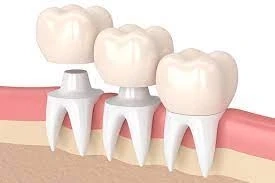Experiencing a loose dental crown can be unsettling, but knowing how to handle the situation promptly can make all the difference in preserving your oral health and preventing further complications. Whether at home or traveling, here’s a comprehensive guide on what to do if you have a loose crown, including immediate steps, temporary solutions, and when to seek professional dental care. If you’re considering crowns and bridges treatment in Chembur East, this blog will be particularly relevant.
Understanding a Loose Crown
A dental crown is a cap-like restoration that covers a damaged or weakened tooth, providing protection and restoring functionality. Crowns can become loose due to various reasons, such as:
- Cement Failure: The adhesive cement used to bond the crown to the tooth may weaken over time.
- Tooth Decay: Decay around the tooth underneath the crown can affect its stability.
- Trauma: Injury or impact to the mouth can cause a crown to loosen or come off.
- Grinding: Habitual teeth grinding or clenching can put undue pressure on the crown.
Immediate Steps to Take
When you notice a loose crown, it’s essential to act quickly to prevent further damage and discomfort:
- Retrieve the Crown: If the crown has come off completely, carefully retrieve and handle it by the crown (not the delicate inner part). Rinse it gently with water to remove any debris or dirt.
- Inspect the Crown and Tooth: Examine both the inside of the crown and the exposed tooth. If there is any debris or cement residue on the crown or around the tooth, gently clean it with warm water and a soft toothbrush.
- Assess Your Tooth: Check the exposed tooth for any signs of damage, sensitivity, or decay. Avoid touching the area unnecessarily to prevent further irritation if you notice any issues or discomfort.
Temporary Reattachment at Home
If you’re unable to see a dentist immediately, you can try these steps to reattach the crown temporarily:
- Clean and Dry: Ensure the crown and tooth are clean and dry. Gently dry the tooth and the inside of the crown with a cotton swab.
- Temporary Adhesive: Purchase a dental adhesive or temporary crown cement from a pharmacy. These products are designed for temporary fixes and can help hold the crown in place until you can see your dentist.
- Apply the Adhesive: Follow the instructions on the product carefully. Apply a small amount of the adhesive or cement to the inside of the crown, ensuring it’s evenly spread.
- Place the Crown: Carefully place the crown back onto your tooth, pressing down gently to ensure it fits snugly. Bite down gently to help secure it in place.
- Avoid Chewing: Until you can see your dentist, avoid chewing on the side with the loose crown. Stick to softer foods and chew on the opposite side of your mouth to prevent further loosening.
When to Seek Professional Dental Care
While a temporary fix can provide relief, scheduling an appointment with your dentist as soon as possible is crucial. Here are signs that indicate you need professional dental care:
- Persistent Pain: If you experience ongoing pain or sensitivity around the tooth or crown.
- Difficulty Eating: If the loose crown makes it challenging to chew or causes discomfort while eating.
- Visible Damage: If the crown is visibly damaged or cracked or the underlying tooth shows signs of decay or other issues.
What to Expect at the Dentist
During your dental visit, your dentist will assess the condition of the crown and the underlying tooth. They may:
- Reattach the Crown: If the crown is undamaged and fits well, your dentist may clean the area and re-cement the crown into place.
- Evaluate the Tooth: Your dentist will check for any underlying issues, such as decay or damage to the tooth structure.
- Recommendations: Depending on the assessment, your dentist may recommend replacing the crown if it’s damaged or no longer fits properly.
Tips for Preventing Loose Crowns in the Future
To reduce the risk of a loose crown or other dental emergencies, consider these preventive measures:
- Regular Dental Visits: Schedule routine dental check-ups to monitor the condition of your crowns and overall oral health.
- Avoid Hard Foods: Be mindful of chewing hard or sticky foods that can put excessive pressure on your crowns.
- Manage Teeth Grinding: If you grind or clench your teeth, discuss options with your dentist to prevent damage to your crowns and teeth.
- Maintain Oral Hygiene: Brush and floss regularly to keep your teeth and gums healthy, reducing the risk of decay around crowns.
Conclusion
Dealing with a loose crown can be unsettling, but prompt action and proper care can help you manage the situation effectively. Remember to act quickly, take temporary measures if needed, and schedule an appointment with your dentist as soon as possible. By understanding the steps involved in emergency care for a loose crown and following preventive strategies, you can maintain oral health and keep your smile looking its best for years.


